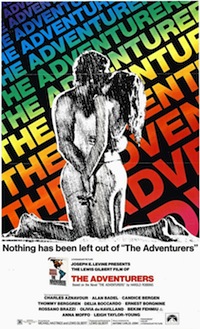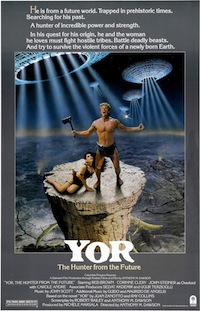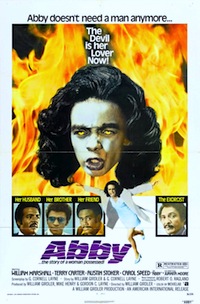 The average filmgoer might be fooled by the lush music and artistic backdrop used in the opening credits of The Adventurers (1970). But any true fan of cool cinema trash will recognize these flourishes as vain attempts at cinematic respectability. When the names of producer Joseph E. Levine and novelist Harold Robbins appear onscreen, you know you’re in for a genuinely trashy experience.
The average filmgoer might be fooled by the lush music and artistic backdrop used in the opening credits of The Adventurers (1970). But any true fan of cool cinema trash will recognize these flourishes as vain attempts at cinematic respectability. When the names of producer Joseph E. Levine and novelist Harold Robbins appear onscreen, you know you’re in for a genuinely trashy experience.
What it’s all about: In the fictional South American country of Corteguay, young Dax Xenos (Loris Loddi) plays on a verdant hillside with his puppy. Their carefree frolicking is soon ended when the dog is shot dead.
Now, what kind of movie kills a puppy in it’s opening moments? This kind. Hang on tight, because there’s lots more sex, violence and melodrama to come.
Dax and the women of the household hide in the cellar as government soldiers ransack their villa. The soldiers rape and kill the women, including the young boy’s mother and sister. Dax escapes and brings back his father (Fernando Rey), a lawyer who has joined in the fight to overthrow the government’s tyrannical regime. Young Dax asks for the honor of killing the captured solders. “For my mother, for my sister, for Corteguay!” he declares, using a machine gun to execute them.
Dax is taken to the relative safety of the hacienda owned by revolutionary General Rojo (Alan Badel). Dax befriends Amparo, Rojo’s daughter. One afternoon the children stumble upon a couple skinny-dipping. “He rapes her and she rapes him,” Dax explains. He declines Amparo’s suggestion that they “play” like the adults do. “I think I have to kill you afterwards.” Boy, this kid is going to need some serious therapy.
Dax and Amparo escape amid gunfire and explosions when the hacienda is set ablaze in a savage nighttime raid. They evade soldiers and overcome harsh weather in a montage of their perilous trek across the rugged countryside. When they finally reach civilization, people are rejoicing in the streets. The government has been overthrown. Amparo’s father is now el Presidente and Dax’s father will become a Corteguayan ambassador.
In Rome, Dax (now played by Bekim Fehmiu) has grown into a suave playboy whose only passion is for fast cars and fast women. His best friends are the well-to-do sons of his father’s business associates, Sergei Nikovitch (Thommy Berggren) and Robert de Coyne (Christian Roberts). After a rousing game on the polo field, Dax and his cohorts race their sports cars through the Italian countryside to the villa de Coyne.
After a party that leaves the house in a shambles, Dax invites Robert’s sister for a midnight swim. With the voyeuristic eyes of countless statuary watching them, Fehmiu and actress Delia Boccardo engage in the first of the film’s laugh-out-loud love scenes. As they silently writhe poolside, Dax envisions the long ago rape of this sister. Strangely, this doesn’t seem to dampen the mood. The camera zooms in and out, in and out, as the scene finally reaches it’s, um…climax. When the Baron de Coyne (Rossano Brazzi) arrives home to find the disgraceful remnants of the previous nights orgy, he cuts Robert off.
When Dax’s father makes a return trip to Corteguay, he is shocked to discover the level of violence and extravagance on which Rojo has built his new regime. When el Presidente is told that Dax’s father has befriended the new revolutionary leader, el Condor, the kindly lawyer is asassinated via an exploding air tram.
Dax returns to take part in his father’s spectacularly lavish state funeral. Presidente Roja, wearing a feathered helmet that makes him look like Big Bird’s fey uncle, asks Dax to continue to honorably serve Corteguay the way his father once did. But before Dax can be persuaded to barter a deal between the government and el Condor, he is reunited with his childhood sweetheart, Amparo (now played by Leigh Taylor-Young). Since no woman can resist him, they’re soon burning up the sheets.
El Condor is convinced to lay down his arms in the name of peace, but it is a trap. Dax and long-time family friend Fat Cat (Ernest Borgnine) helplessly watch as tanks and soldiers on horseback massacre the oblivious revolutionaries. “Until you’ve learned that evil and politics must tolerate each other,” Rojo explains, “There’s no place for you here.”
Leaving Amparo and his homeland behind, Dax vows, “I’ll do anything to get money and power… and then I shall come back.”
“Anything” apparently includes turning tricks. Now penniless, Dax, Sergei and Robert come up with a cockamamie scheme to woo wealthy American women and raise the funds for a dress salon that will feature Sergei’s designs. Since the best way to earn a quick buck (according to the twisted logic of the movie) is to open an exclusive European fashion house, the boys immediately get to work.
One of Dax’s female patrons is Deborah Hadley, played by Olivia de Havilland. Though her role is little more than a cameo, de Havilland conducts herself with a level of grace that belies the actual material. When Dax arrives at her hotel suite, she primly asks, “Maybe this whole thing’s a little ridiculous?”
Is she questioning the film, or her role in it? As expected, she finds him irresistible and after several days of making love and seeing the sights, she pays him a tidy sum for services rendered.
As any fan of cool cinema trash can attest, the only thing better than watching a really good bad movie, is a really good bad movie with questionable fashion. Cinematic runway shows are always good for a laugh and The Adventurers doesn’t disappoint. Models, wearing Sergei’s designs, traipse through ancient roman ruins to the delight of an appreciative audience.
After the show, Dax sets his sights on poor little rich girl Sue Ann Daley (Candice Bergen). They begin their affair with a lover’s montage. Their entire courtship is covered within minutes as they glide along the canals of Venice and visit the fountain of Trevi. Sue Ann celebrates turning 21 at a swanky party where fireworks illuminate a sparkling portrait and spell out “Happy Birthday Sue Ann”.
But Dax has a different kind of celebration in mind. In a moment that practically bashes the viewer over the head with sexual symbolism, he deflowers Sue Ann in a greenhouse filled with exotic blooms. Fireworks explode outside as they literally get hot and sweaty in the film’s second giggle-inducing love scene.
When Sue Ann fumes, “This is really humiliating,” you may wonder if Bergen has broken character and decided to comment on her choice of film roles. Actually, she’s upset because Dax is late for their wedding day. Dax isn’t about to pass up Sue Ann’s millions and the ceremony goes off without a hitch. Their honeymoon doesn’t last for long. While pushing his expectant bride on a swing, the chain breaks and Sue Ann takes a nasty fall.
So far, the wooden performances of Bergen and Fehmiu have been evenly matched. But when she tells him that she has miscarried and can no longer have children, Bergen emotes as if she were in an old Douglas Sirk melodrama. In any other film, it’s at this point that the end credits would roll, but for The Adventurers, it’s only the intermission.
Civil war continues to rage in Corteguay. El Lobo has taken up the fight against Rojo’s fascist government. The revolutionaries successfully raid an airfield and prevent munitions from entering the country. Meanwhile, in New York, we get to watch another of Sergei’s ridiculous fashion shows. Models wearing outrageously mod outfits prance and pose on a flashing disco dance floor.
After the show, a reporter from Teen magazine (future Charlie’s Angel Jacyln Smith) asks Dax, “Is it true you’ve made love to every woman in this room?” The answer would seem to be yes. In the past five years, Dax has been busy marrying and divorcing several wealthy women. Sergei is now unhappily married to Sue Ann. She, in turn, is having an affair with his mistress.
Dax begrudgingly returns to Corteguay for the lavish dedication of a memorial in his father’s honor. He visits Amparo, who has spent the past several years in a convent in exile. She reveals that she has a child, Dax’s son.
Rojo requests that Dax help raise capital for the fight in Corteguay. Olivia de Havilland returns for a brief moment as her wealthy and influential husband helps Dax raise the millions he needs. On the Brooklyn Bridge, Robert informs Dax that he has been double-crossed. An old business associate (Charles Aznavour) has been profiting from the war and making secret deals with Rojo. With Fat Cat’s help, they imprison the swindler in his own outrageously decorated secret pleasure dungeon.
Dax returns once again to his homeland and helps el Lobo stop the new weapons shipment. In an extravagant battle sequence, they destroy a train carrying troops and weapons. A new revolution is born and the march toward the capital city begins. Dax is disillusioned with his country’s tumultuous and bloody history, “Pillage. Rape. Destruction. Death. It’s always the same.”
As the people celebrate their victory on the steps of the presidential palace, Rojo begs for swift justice. When Dax refuses to kill him, Rojo admits that he issued the order to kill Dax’s father. Well, when you put it that way. Dax empties several rounds into el Presidente.
Dax later finds his son and Amparo nursing the wounded in a makeshift hospital. “Don’t save me just to leave me Dax,” she pleads as they make plans to escape to Rome. In a frustratingly cynical ending, Dax stays behind as he sends his loved ones to the airport. In the capital square, the son of el Condor exacts revenge for his father’s betrayal and shoots Dax in the back. As the sun rises on a new day, our hero lays dead in the shadow of his father’s monument.
Talk about a downer.
In Conclusion: With a running time of nearly 3 hours, The Adventurers is big in every conceivable way. Shot on location all over the world and (in certain cases) featuring a cast of thousands, it’s certainly the most lavish adaptation of a Harold Robbins bestseller ever brought to the silver screen. Millions were spent to achieve a grandeur that matched the large-scale scope of the story. Director Lewis Gilbert, who was best known for his action films, seemed a logical choice to handle a project of this size. With three James Bond films to his credit, his expertise at staging large-scale fight sequences was certainly put to good use in The Adventurers. The epic battle scenes, with exploding trains, planes and tanks, are some of the most effective in the movie. But whenever the action shifts towards the quieter, character driven moments, Gilbert seems to loose interest. Despite the fact that he co-wrote the script, most of the dramatic scenes are handled in a flat, unimaginative way.
Yugoslavian born Bekim Fehmiu was unknown to American audiences when he was cast as the charismatic stud Dax Xenos. Though handsome in a brutish sort-of way, Fehmiu’s performance is fascinatingly stilted. Every moment, whether big or small, is played with the same stony-faced indifference. Every female character falls for him instantly, despite the fact that he is practically charisma-free.
His co-stars don’t fare much better. With the exception of de Havilland, the other leading ladies seem at a complete loss. There’s little chemistry between Fehmiu and Candice Bergen. The Adventurers was early in her transition from model to actress. She would eventually go on to bigger and better things. Fehmiu, on the other hand, never made another American film, though he successfully continued his career in Europe.
When The Adventurers was released in 1970, it was originally rated R. Two years later it was re-released in an edited PG version. The DVD contains the original uncut version of the film, though it has mistakenly been labeled as PG.
Like most of the movies based on a Harold Robbins potboiler, we’re supposed to be shocked by the scandalous nature of the story. But with ludicrous sex scenes, spectacular violence, funky fashions, and stars that are obviously slumming, the only thing that’s shocking about The Adventurers is that audiences were expected to take it seriously.




